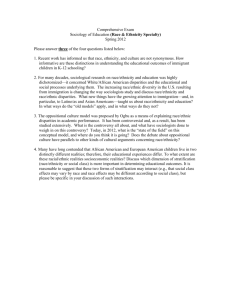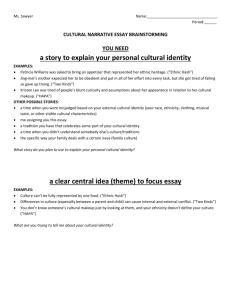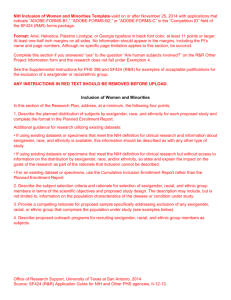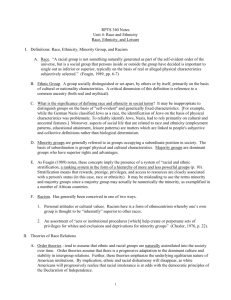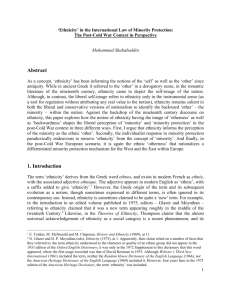CHAPTER 11: RACE AND ETHNICITY Part 1 “Give me your tired
advertisement
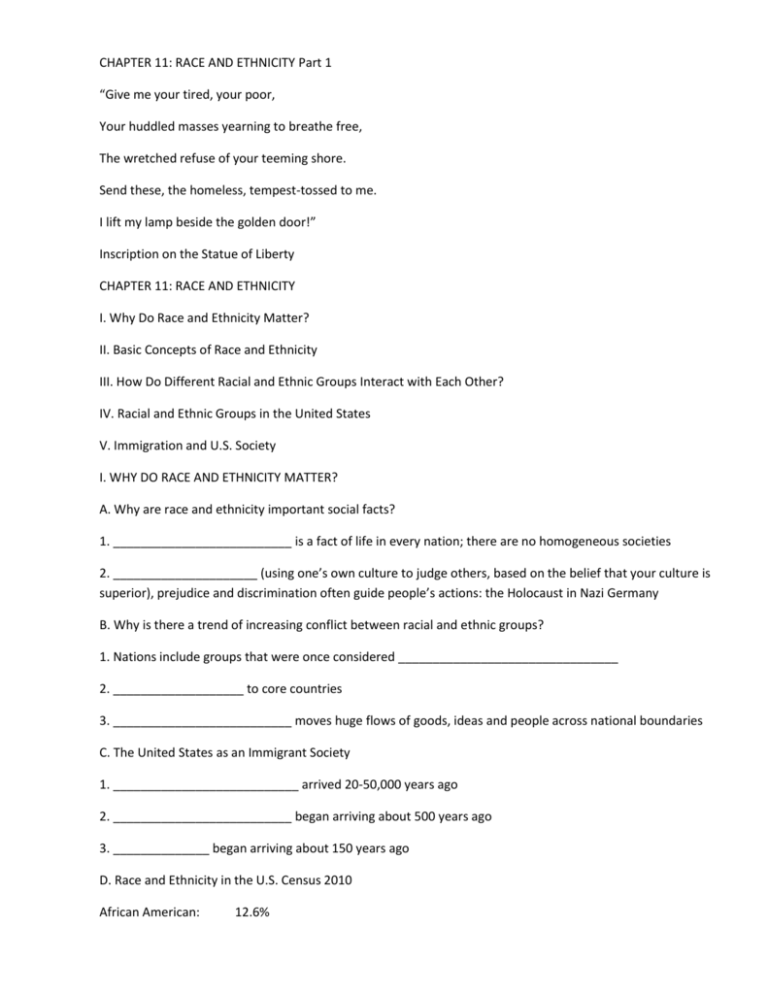
CHAPTER 11: RACE AND ETHNICITY Part 1 “Give me your tired, your poor, Your huddled masses yearning to breathe free, The wretched refuse of your teeming shore. Send these, the homeless, tempest-tossed to me. I lift my lamp beside the golden door!” Inscription on the Statue of Liberty CHAPTER 11: RACE AND ETHNICITY I. Why Do Race and Ethnicity Matter? II. Basic Concepts of Race and Ethnicity III. How Do Different Racial and Ethnic Groups Interact with Each Other? IV. Racial and Ethnic Groups in the United States V. Immigration and U.S. Society I. WHY DO RACE AND ETHNICITY MATTER? A. Why are race and ethnicity important social facts? 1. __________________________ is a fact of life in every nation; there are no homogeneous societies 2. _____________________ (using one’s own culture to judge others, based on the belief that your culture is superior), prejudice and discrimination often guide people’s actions: the Holocaust in Nazi Germany B. Why is there a trend of increasing conflict between racial and ethnic groups? 1. Nations include groups that were once considered ________________________________ 2. ___________________ to core countries 3. __________________________ moves huge flows of goods, ideas and people across national boundaries C. The United States as an Immigrant Society 1. ___________________________ arrived 20-50,000 years ago 2. __________________________ began arriving about 500 years ago 3. ______________ began arriving about 150 years ago D. Race and Ethnicity in the U.S. Census 2010 African American: 12.6% Asian American: 4.8% Latino: 16.3% Native American: 0.9% Native Hawaiian/Pacific Islander: 0.2% Other: 6.2% Two or More Races: 2.9% White: 63.7% II. BASIC CONCEPTS OF RACE AND ETHNICITY Group Assignment: 1. How many races are there in the world? 2. How many races are represented in this room? 3. How do we classify people into different races? A. __________: a category of people who perceive themselves and are perceived by others as distinctive on the basis of certain biologically inherited traits 1. no _____________________________ biological definition of race; there may be 1, 2, 40, or 2,000 different “races” based on biological characteristics such as skin color, eye color, hair color, other genetic factors A.2. thousands of years of ________________________________________ have mixed the gene pool 3. instead, race is a ___________________________ category based on shared social definitions, perceptions, and beliefs 4. in our society, these definitions are mainly based on ____________________, but other societies use characteristics of appearance, dress, and language to define races B. ______________________: people who perceive themselves and are perceived by others as sharing distinctive cultural traits such as language, religion, family customs, and food preferences 1. typically used to describe subgroups within _____________________ 2. Example: ____________________________ in the 1800s C. ___________________________: group of people in a given society who, because of their distinct physical or cultural characteristics, find themselves in situations of inequality compared with the dominant group within that society 1. based on ______________________________ of race and ethnicity 2. NOT based on numerical size of groups 3. ____________________________ can be minorities, e.g. blacks in South Africa under apartheid C.3. Characteristics of minority groups: a. membership is usually ascribed involuntarily through ________________ b. physical or cultural traits are held in _____________________ by the dominant group c. _________________ treated by the dominant group d. tend to _______________ within their own group e. tend to feel strong _____________________ D. ____________________________: the group with the most wealth, most power, greatest privileges, and highest social prestige 1. this power and wealth allows the dominant group to ________________________ against minority groups 2. just as being male systematically benefits men, being __________________ systematically benefits white people in our society D.3. What does “systematically benefits white people” mean? a. unequal treatment by _____________________________ b. median ____________________________ in 2012: whites: $57,009 African-Americans: $33,321 Latinos: $39,005 D.3.c. does NOT require that individual members of the dominant group _________________________ against members of minority groups or that they have strong prejudices against minorities d. prejudice and discrimination are part of our ____________________ (e.g. values of racism and group superiority) and social institutions (e.g. the justice system) E. __________________________: behavior that denies to the members of a particular group resources or rewards that can be obtained by others; an act of unfair treatment directed against an individual or group 1. often ______________________: beating someone up, refusing to hire someone 2. _____________________________________: patterns of discrimination based on ethnicity that have become structured into existing social institutions; e.g. banks often refuse to lend money to members of minority groups who want to buy a house F. _____________________: holding preconceived ideas about an individual or group; may be either positive or negative 1. typically learned via ____________________________ from family, peers, and/or media negative stereotypes about minority groups 2. very difficult for individuals to ________________________________________ or to change these attitudes, but it is possible and does happen G. _________________: the attribution of characteristics of superiority or inferiority to a population sharing certain physically inherited characteristics; prejudice and discrimination on the basis of race 1. Why does racism seem to be increasing in the U.S. over the last thirty years? a. declining economic position of poor, working class, and middle class whites leads to fear of competition from minorities & __________________________: individuals or groups blamed for wrongs that were not of their doing b. ______________________ feel that “there are enough laws to protect minorities” III. HOW DO DIFFERENT GROUPS INTERACT? A. ______________________: systematic, planned destruction of a racial, political, or cultural group; systematic annihilation or attempted annihilation of a people based on their presumed race or ethnicity 1. Example: the Holocaust in _________________________ to wipe out Jews, Gypsies and other minorities B. ________________________________: involuntary movement of a minority group 1. Example: moving ______________________________ from the Southeastern states to Oklahoma during the 1800s B.2. Combination of genocide and population transfer: ____________________________: the creation of ethnically homogeneous territories through the mass expulsion of ethnic populations; a policy of population elimination, including forcible expulsion and genocide 3. Example of Ethnic Cleansing: __________________, with previously intermixed and intermarried Serbs, Croats and Muslims being separated forcibly into different regions C. ____________________________________: the policy of economically exploiting minority groups by using social institutions to deny them access to full benefits of citizenship 1. Examples: a. Apartheid in ___________________________, with blacks forced to work for whites in mines and on farms C.1.b. __________________________________ in the U.S.; after the end of slavery, whites continued to own land and blacks received very low payments for their labor and were in perpetual debt to former plantation owners C.2. __________________________: practices of keeping racial and ethnic groups physically separate, thereby maintaining the superior position of the dominant group; enforced separation of racial or ethnic groups under internal colonialism 3. Example: ________________________________ in many parts of the U.S. had separate schools, restrooms, and water fountains until the 1950s and 1960s D. _____________________________: acceptance of a minority group by a majority population, in which the new group takes on the values and norms of the dominant culture 1. ______________________: the idea that ethnic differences can be combined to create new patterns of behavior drawing on diverse cultural sources; the view that Americans of various background would blend into an ethnic stew D.2. _________________________________: English, Irish, German, Scandinavian descendants have all been melted into U.S. culture and society 3. ______________________________: Native Americans forced to attend boarding schools and not allowed to learn their own languages E. _____________________: a model for ethnic relations in which ethnic groups retain their independent and separate identities yet share equally in the rights and powers of citizenship 1. Example: Coexistence of diverse groups in the ______________________ F. ____________________________: condition in which ethnic groups exist separately and share equally in economic and political life 1. Example: _________________________ with French, German, and Italian groups




